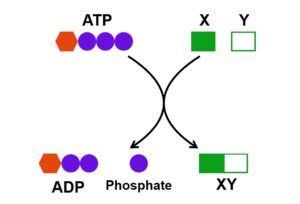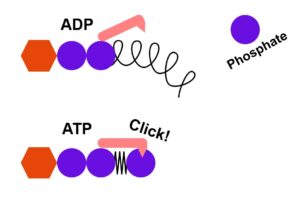Welcome!
Hello! I’m Mark!
Welcome to my blog.
This is the FIRST POST on my blog!
On this blog, I will write about little topics in biology that I like.
Don’t worry!
I’m not going to write anything so difficult.
Recently, you frequently see biological words in the news, right?
… For example, PCR, DNA, Messenger RNA, … etc.
I would just like to try to give short explanations for these little biological words.
Now, enjoy my blog, and let’s start!
ATP!
My first theme is “ATP”.
What is ATP?
Typical textbooks often say as …
“ATP is the “Energy Currency” for life”…
“Energy Currency”…
What does it mean???
Is that a kind of money???
NO!It’s not money.
ATP is just a small molecule.
And this guy is made in the mitochondria.
In the mitochondria, ATP is made using the energy taken from food.
And ATP is distributed to all parts of the cell and is used as an energy source for various mechanisms to work.
How does ATP become an energy source?
You sometimes see this kind of diagram in biology textbooks, right?

And you might see this kind of explanation below, written for this diagram.
- Let’s say that energy is required for molecule X and molecule Y to bond together to form molecule XY.
- In this case, even if X and Y just keep together, they will never be XY.
- Cells use this energy.
That is, cells carry out two reactions below at the same time.
X + Y -> XY
ATP -> ADP + Phosphate
In this process, cells use the energy from ATP to make XY!
Hmmm …
Not so easy to understand…
A Spring Toy
Instead, how about the following?
“ATP has higher energy than ADP”.
How about understanding the above in the following way?
- ADP: A spring in a stretched and relaxed state.
- ATP: A spring tightly compressed and fastened by a clamp.

In the mitochondria, the spring of ADP is tightened and ATP is created. This unstable ATP, which looks as if it is about to burst, is distributed to all parts of the cell. At the destination, for example, a device (enzyme) is waiting to make XY from X and Y.
The ATP comes to the enzyme, and the spring of the ATP bursts. Then, the force of the spring causes the enzyme to produce XY.
This is how ATP works as an energy source for life!
How about this image?
Yes, you’re right!
Of course, in reality, ATP does not have a spring.
But anyway, the essential role of ATP is “to be a small, easily transportable media in which energy can be temporarily stored.”
So I think it’s kind of a good idea to play with these imaginary toys with springs.
Mitochondria are Power Plants. So What about ATP?
Playing with this toy, you’ll notice something.
It’ s a very clever way to store energy in this small media and distribute it.
Getting energy out of food requires a complex, large-scale mechanism.
So it is impossible to place such a huge mechanism in every place in the cell where vital activity is taking place.
So, the cell decided to have mitochondria, a “factory” specialized for energy generation.
Energy is efficiently generated in the mitochondria and efficiently stored in ATP. The ATP is then distributed to the devices that are carrying out each life activity.
Because of the system above, each device is now free from energy generation. Now each device can simply receive energy from ATP and focus on its own life activity.
In other words, mitochondria are “power plants.”
Electricity is efficiently generated in power plants that specialize in power generation, and then distributed to factories and homes. Thanks to this, factories and homes are freed from generating electricity and can focus on making products or running households.
In this analogy, ATP would be equivalent to a wire that carries electricity.
In this way, in a sense, the inside of a cell and human society have the same structure.
I think this is very interesting!